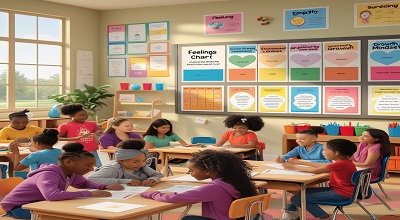Classroom Climate
In recent years, the importance of classroom climate and social-emotional learning (SEL) has gained significant attention in educational discourse. As educators strive to create environments conducive to learning, understanding the interplay between classroom climate and SEL becomes essential. This article delves into the latest insights, strategies, and research surrounding these critical components of education, aiming to provide a comprehensive overview for educators, administrators, and stakeholders.
Understanding Classroom Climate
What is Classroom Climate?
Classroom climate refers to the psychological and emotional atmosphere of a classroom. It encompasses the interactions between students and teachers, the physical environment, and the overall culture of the classroom. A positive classroom climate fosters a sense of belonging, safety, and respect among students, which is crucial for effective learning.
Importance of Classroom Climate
A supportive classroom climate is linked to numerous positive outcomes, including:
Classroom Climate & Social-Emotional Learning (SEL) – Latest Insights
Monday, February 03, 2025 03:01 UTCSocial-emotional learning (SEL) has emerged as a critical component of modern education, with growing recognition of its profound impact on student development, academic success, and overall well-being. As educators strive to create engaging and supportive learning environments, understanding the latest trends and best practices in classroom climate and SEL is essential.
The Importance of Classroom Climate for SELEstablishing a positive classroom climate is foundational to effective social-emotional learning. Research has shown that a classroom environment that fosters trust, respect, and emotional safety is crucial for students to develop self-awareness, self-management, social awareness, relationship skills, and responsible decision-making – the core competencies of SEL.
When students feel accepted, valued, and supported, they are more likely to take risks, engage in meaningful discussions, and collaborate effectively with their peers. A classroom climate that prioritizes social-emotional development can lead to improved academic performance, reduced behavioral issues, and enhanced overall student well-being.
Strategies for Cultivating a Classroom Climate Conducive to SEL.
Modeling Emotional Intelligence:
Educators can set the tone by modeling emotional awareness, empathy, and effective communication. When teachers demonstrate these skills, students are more likely to emulate them.
Establishing Clear Expectations and Routines:
Consistent classroom routines, clear behavioral expectations, and collaborative rule-setting can help students feel secure and develop self-regulation skills.
Fostering Positive Relationships:
Intentionally building strong, supportive relationships between teachers and students, as well as among students, can create a sense of community and belonging that supports SEL.
Incorporating SEL-Focused Activities:
Integrating SEL-specific lessons, group discussions, and experiential learning opportunities into the curriculum can directly address the development of social-emotional competencies.
Promoting Inclusive and Equitable Practices:
Ensuring that all students feel respected, valued, and included, regardless of their background or identity, can create a classroom environment that nurtures social awareness and empathy.
Implementing SEL in the Classroom:
Effective implementation of social-emotional learning in the classroom involves a multifaceted approach that addresses both the instructional and the relational aspects of the learning environment.
Instructional Strategies for SEL:
- Explicit SEL Instruction: Dedicating specific lessons or units to teaching SEL skills, such as self-awareness, self-management, social awareness, relationship skills, and responsible decision-making.
- Integrating SEL into Academic Subjects: Weaving SEL concepts and competencies into the teaching of core academic subjects, such as language arts, social studies, and science.
- Project-Based and Collaborative Learning: Designing learning experiences that require students to work together, solve problems, and develop interpersonal skills.
- Mindfulness and Stress Management: Incorporating mindfulness practices, breathing exercises, and other stress-reduction techniques to help students regulate their emotions and manage their well-being.
Relational Strategies for SEL
- Positive Student-Teacher Relationships: Fostering strong, supportive relationships between teachers and students, built on trust, empathy, and mutual respect.
- Peer-to-Peer Interactions: Encouraging and facilitating positive interactions, collaboration, and conflict resolution among students.
- Family and Community Engagement: Involving families and community members in the SEL process, creating a holistic approach to student development.
- Trauma-Informed Practices: Recognizing and addressing the impact of trauma on student learning and behavior, and implementing strategies to create a safe and supportive environment.
The Future of Classroom Climate and SELAs the educational landscape continues to evolve, the importance of classroom climate and social-emotional learning will only grow. Emerging trends and future directions in this field include:
- Increased Integration of Technology: The use of digital tools and platforms to enhance SEL instruction, foster virtual collaboration, and support student well-being.
- Personalized SEL Approaches: Tailoring SEL interventions and support to meet the unique needs and developmental stages of individual students.
- Emphasis on Equity and Inclusion: Ensuring that SEL practices are culturally responsive and address the diverse needs of all students, particularly those from marginalized communities.
- Expanded Partnerships and Interdisciplinary Collaboration: Fostering stronger connections between schools, families, mental health professionals, and community organizations to provide comprehensive SEL support.
- Ongoing Professional Development for Educators: Investing in continuous training and support for teachers to enhance their SEL competencies and classroom management skills.
Summary
I hope this comprehensive overview of the latest trends and best practices in classroom climate and social-emotional learning has been informative and insightful. Remember, creating a positive and supportive learning environment that nurtures the whole child is essential for fostering academic success, social-emotional development, and lifelong well-being.
